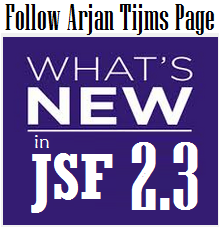[OmniFaces utilities] The
Message class represents the OmniFaces
faces message builder.
Class:
Usage:
In order
to use the OmniFaces faces message builder, we start from a faces message with the default INFO severity
and the given message body which is formatted with the given parameters as
summary message. This message can be obtained via Messages#create() method as
below:
import
org.omnifaces.util.Messages;
import
org.omnifaces.util.Messages.Message;
...
private
static final String FILES_UPLOADED_ERROR = "The {0} file cannot be
uploaded ! File size should be smaller than {1} bytes !";
...
Message msg =
Messages.create(FILES_UPLOADED_ERROR, "order.txt", 1024);
Now, we
can:
- set the
detail message via Message#detail(String, Object...)
- change
the default INFO severity via Message#warn(), Message#error(), or Message#fatal()
- make it
a flash message via Message#flash()
- add it
to the faces context via Message#add(String) to add it for a specific client ID
- or, add
it to the faces context via Message#add() to add it as a global message
For
example, we can change the default INFO severity in ERROR, make it a flash
message and add it in the faces context as a global message, as below:
msg.error();
msg.flash();
msg.add();
Or, you
can put everything in a compact line:
Messages.create(FILES_UPLOADED_ERROR,
"order.txt", 1024).error().flash().add();
The
resulted message will be:
// ERROR
message
The
order.txt file cannot be uploaded ! File size should be smaller than 1,024
bytes.
Note Don't
forget to use in page where the messages are displayed the <h:messages>, for
global messages, <h:message>, for component messages, or any other
approach capable to display the messages.











 Arrays
Arrays Converters
Converters














 JSF 2 Tutorials at www.mkyong.com
JSF 2 Tutorials at www.mkyong.com  JavaServer Faces (JSF) Tutorial
JavaServer Faces (JSF) Tutorial 




















